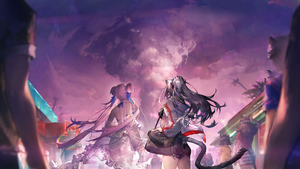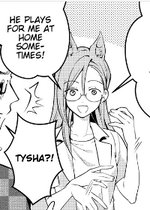Siesta
| Faction | Overview | Gallery | Trivia |
Siesta, formally known as the Siestan Commonwealth, is a Terran country on a peninsula in the Sea of Clariside bordering Sargon, Victoria, and Iberia. It is an independent city-state republic with a city council that is under the nominal jurisdiction of Columbia as its commonwealth. Siesta is also well-known for the scenery of its tropical beaches and its proxy to a volcano that holds a vast reserve of obsidian deposits.
Siesta began as a Columbian trading outpost meant to establish diplomacy with Iberia, but the Profound Silence severed its ties from its homeland which in turn stirred the locals' desire to retain their independence and self-rule. As Victoria attempted to annex the country, Siesta decided to bring itself under Columbian jurisdiction, yet it still retains de facto independence in terms of diplomacy and sovereignty, preserving the only independent city-state on Terra. In recent decades, Siesta greatly prospers thanks to its flourishing tourism, though a natural disaster in 1097 has forced the city-state to migrate onto mobile platforms.
The Siestan language is an amalgamation of Victorian, Columbian, and Iberian similar to Caribbean Spanish and Hawaiian Pidgin in our world, but has distinct grammars and accents even though both are mutually intelligible with each other.[1]
History
Foundation era
Ever since the Columbian independence of 1019, Columbia yearned to establish diplomacy and economic ties with Iberia. In 1025, a group of frontier pioneers uncovered the ancient "southern passage," originally a Sargonian imperial highway that had long been abandoned, and sought to revitalize this ancient passage to reach Iberia. As the pioneers cleared the boulders and bushes that blocked the passages, various pioneer settlements were built along this trading route. A decade later, with the aid of the Union Army and veterans of the Revolutionary War, the pioneers managed to uncover an unclaimed land near the coastline that was nearly undisturbed by Catastrophes. Seeing the place as an ideal sedentary settlement, the Columbian pioneers set up a trading outpost, and they gave the outpost name "siesta," Iberian for "afternoon nap" that specifically refers to a region with very low Catastrophic activities.[2]
In the beginning, Siesta duplicated the political structure of an Iberian trading outpost; the Siestans set up a simple "city assembly" and encouraged Iberian merchants to settle there. These Iberian goods were then transported back to Columbia via caravans traveling the "southern passage" cleared by the pioneers. Nevertheless, the foundation of Siesta brought diplomatic tension between Columbia and Iberia. The Iberian royal court strongly protested the Union Army's presence in its sphere of influence in the Sea of Clariside, and local Siestans had urged the Department of Defense to regulate military activities in the region to not provoke Iberia.[2]
Post-Profound Silence era
The Profound Silence of 1038 not only brought the sudden collapse of the Iberian regime, but also Siesta was affected by the natural disaster indirectly. Columbia's plan to establish diplomacy with Iberia was interrupted, and the trading route was completely cut off as Iberian goods were no longer imported back. Furthermore, the tsunami that drastically altered the coastlines of the Sea of Clariside caused the Columbians to be weary of traveling via seas. The loss of strategic value forced the Union Army to withdraw all of the veterans stationed in Siesta. The DOD's failed military campaign in Bolívar and the revocation of their power under the Federal War Preparation Act of 1056 forced the Union Army to give up follow-up plans in Siesta as the Union Congress constantly rejected their proposals.[3]
Without support from their homeland, Siesta developed independently to become a unique city-state. Wastelanders began arriving at the city along with immigrants of different cultures from all over Terra, drastically changing the city's image in the following decades. Due to the Profound Silence, Siesta suddenly became a coastal city-state with beautiful beaches; so, the Siestans used this unfortunate opportunity to promote tourism in the city-state. Most importantly, through the trading route between Sargon and Victoria, Siesta earned a huge profit from the mining of obsidian before its outlaw in 1082. Within a few decades, Siesta quickly recovered from the aftermath of the disaster, turning the once isolated city-state into a vibrant tourist hotspot.[3]
Commonwealth era
Siesta's prosperity eventually attracted attention from other superpowers in the Terran heartland, notably from Victoria. In 1066, Victoria sent a unilateral invitation to Siesta that offered annexation under Victoria's rule, but most of the citizens quickly protested over Victoria trespassing their sovereignty. Herman Doykos, a renowned entrepreneur in Siesta, then proposed to the city assembly to reestablish communication with Columbia and bring the city-state under its nominal jurisdiction as its commonwealth. He firmly believed that Siesta had enough bargaining chips with the Columbian government to provide military protection upon Siesta while retaining their sovereignty, and Columbia would not alter the status quo as it deemed the region no longer having strategic values.[3]
Following a national discussion to persuade its citizens, Siesta formally sought political negotiations with the Columbian Federal Government. Columbia agreed to have Siesta becoming its commonwealth while retaining its sovereignty. After a referendum, SIesta was formally declared to become a Columbian commonwealth. Since then, Siesta no longer received diplomatic offers from Victoria, and Victoria became extremely cautious when facing Siesta as this small city-state has become a nominal Columbian exclave.[3]
Giving the opportunity, Herman Doykos pursued to reform the city into his vision to dedicate the city-state back to the memories of his late wife, Barbara Doykos, by transforming Siesta into his ideal paradise. Through his charisma among the populace and communication gap between the city-state and the Federal Government, Herman proposed to reorganize the city assembly to a more formal City Council and City Congress. The reformation allowed Siesta to formally become a de facto independent city-state, and Herman was elected as the mayor of Siesta.[3]
Herman's leadership in Siesta, however, was painted in an ungrateful past to his opponents. Under his administration, the previous inhabitants of Siesta, namely the Taraks, were forcibly persuaded to assimilate into Herman's vision of the peninsula as a tourist city.[4]
Nomadic Siesta
In the following decades, Siesta has successfully retained both its prosperity and its sovereignty. Every year, the city attracts many visitors all around Terra, whether to enjoy the tropical seashores or to watch the annual Obsidian Festival where many famous musical artists participate. Nevertheless, the illegal mining of obsidian that triggered the infestation of multiple Originium slug colonies inside the volcano resulted in the dormant Mount Siesta becoming active once again.
Ever since the revival of volcanic activity in July 1097, the City Council declared to relocate the citizens into a newly built nomadic city now called the "Nomadic Siesta" and let the volcano magma reclaim the land. By 1099, most of the relocation was nearly done, and the citizens were given the opportunity to witness the once-in-a-life-time "White Volcano" amidst the eruption which the Siestans deemed to be a farewell ceremony to old Siesta.
Siesta's migration to the nomadic platforms also results in Columbia's constant interference in Siesta's affairs. The Federal Government pressures the Siestan government to implement Columbian laws, notably the notorious Infected medical healthcare premium and the frontier pioneer program upon citizens of Nomadic Siesta.[5] Nevertheless, Siesta still retains its independence despite Columbia monitoring their actions, and Hermann often rebukes Columbia's interference. Certain government agencies like the Columbian Tax Bureau are forbidden to sway control over the local businesses.[6]
Notable people
| Migrant | |||
|---|---|---|---|
- Barbara Doykos☠: A Victorian scholar who was Herman's wife. Although the Siestans were against Victoria's plans to annex them, she stood back and decided to protect the city on her on way, vowing for its development and the proper medical attention of the Infected workers who contracted Oripathy through obsidian mining.[7] She eventually passed away after giving birth to her only daughter, Ceylon Doykos, and her body was buried by Herman at the site near Mount Siesta.
- Beat Brown☠: A Siestan tycoon who was Pelipper Brown's father. He rose in prominence during Old Siesta's Obsidian Rush and was the owner of various mines. However, he would declare bankruptcy after the government banned the obsidian mining operations in Siesta. He passed away of Oripathy a couple of years ago, after his car's Originium engine broke down on his way to Columbia.[8]
- Costa's grandfather☠: The previous owner of the Mockingbird Café, located in Old Siesta's Second Avenue. As a memento to his deceased wife, he decided to decorate the restaurant with her favorite flowers and bonsai trees, and play her favorite songs at the background. However, as he was getting too old to continue working, he passed down the family business to Costa, who would later leave in favor of a job position in the City Hall. He would eventually pass away due to sickness.[9][10]
- Chuck: Harley's husband and adoptive father of Enis Visser, Liv, and Lut
- Tysha: Costa's fiancée and later wife who, unlike the former, is noted for her cheerfulness.[10] She convinces Costa to join Vigna's improvised rock band for a music contest.[11]
Enemies
| Normal | |
|---|---|
| Elite |
Landmarks
Old Siesta
- Civic Square: A square in which a rock party and beer stalls are held during the festival. Siesta's City Hall is also located on this street[12]
- Herman Hotel: A hotel on Second Avenue which is named after the mayor.[12]
- Garrison Amusement Park: Having the largest stage in Siesta, this is where the biggest concerts of the Obsidian Festival are held. During the festival, the park is open 24/7.[12]
Nomadic Siesta
- Ultramodern District: The heart of New Siesta. It was completed in two years from conception to investment, making it one of the fastest-built high-rise city plates in Terra. It houses various luxury restaurants, as well as three mega business complexes and a "volcanic style" municipal plaza built in collaboration of eleven different artists and architects.[1] The core skyscrapers and buildings are positioned in a way they resemble a volcanic cone.
- Seaside Fashion Street: Also known as Siestan Fashion Street or simply Fashion Street, a district conformed by some of the relocated stores and businesses from Old Siesta's Seaside Street, though not many people come to travel there. It is said that remodeling plans are being discussed.[1]
- Obsidian Hot Springs Hotel: Owned by Pelipper Brown, it is a resort equipped with artificial hot springs, specifically engineered based on recompiled and analyzed data from various natural hot springs, delivered through the ecological stations. These hot springs, powered directly by the power layers, bring various beneficial effects such as including immune system boosting and muscle relaxation.[1]
- Volcano Museum of Siesta: A volcanology museum and research center where Adele Keller works as a curator, built as per Herman's request a year ago. Considered the first museum on Terra to be completely dedicated to volcanoes thanks to Siesta's constant efforts on the field of volcanology, it also displays various research notes, photos, and salvaged pieces of equipment from the late Katia & Magna Naumann, as Keller intended the museum as a last memento to the couple's legacy. The museum is open from Tuesday to Sunday at 09:00 a.m. to 18:00 p.m., and often prepares activities for the visitors.[1]
- White Volcano: A restaurant owned by Harley and her son Enis which is named after a supposed natural phenomenon where Mount Siesta turns white.
References
|


